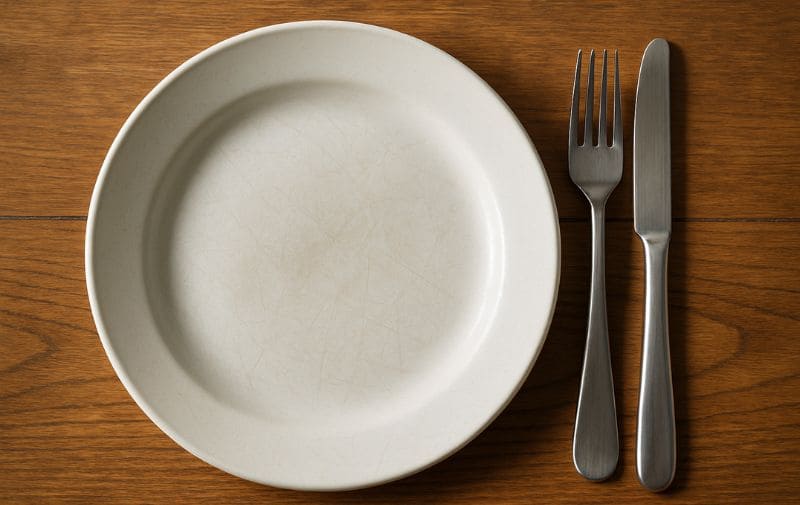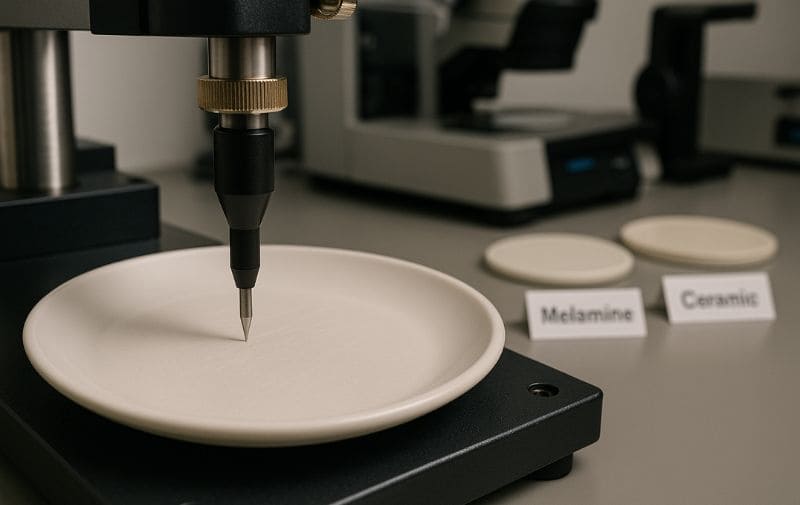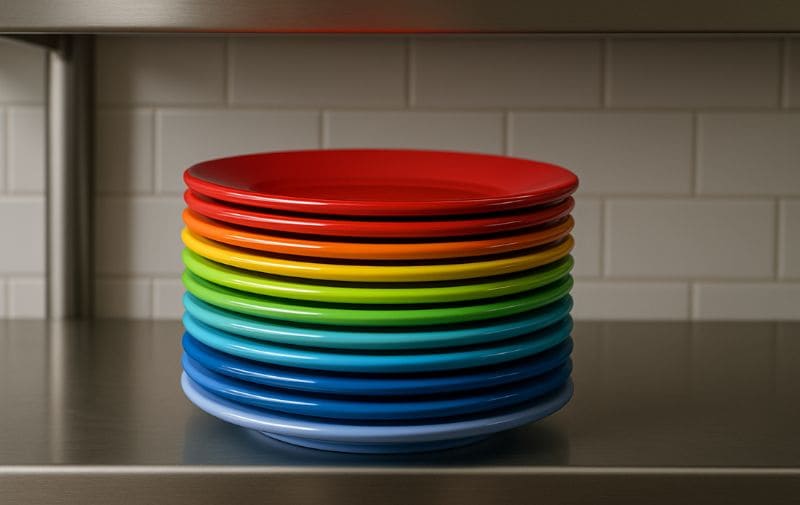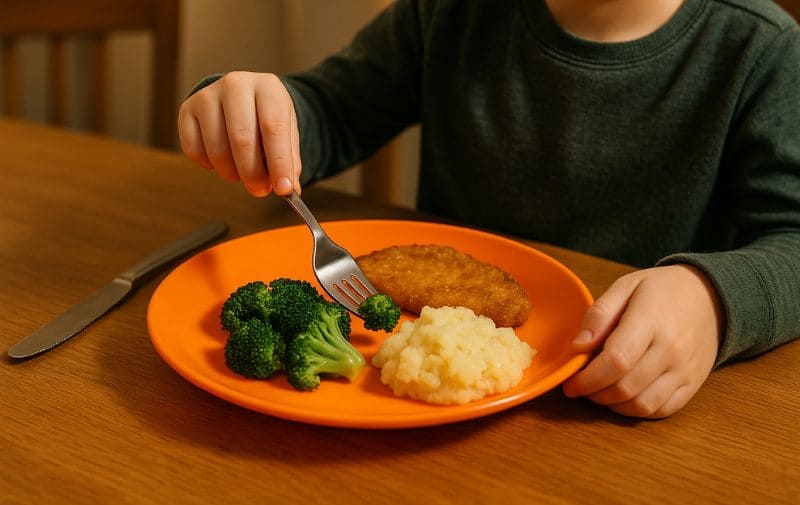Melamine plates are celebrated for being incredibly chip-resistant and durable, making them a popular choice for families, outdoor dining, and busy households. But a common question pops up: do melamine plates scratch? And if so, how easily?
Yes, melamine plates can scratch. While highly chip and break-resistant, their surface is not impervious to marks from sharp utensils like knives (especially serrated ones) or abrasive cleaning methods. Normal daily use is usually fine.
I adore my melamine plates for outdoor dining and for when the kids are using them. They are fantastically durable and lightweight, and I’ve seen them survive drops that would have shattered ceramic instantly. But over time, I started noticing fine lines and marks, especially on the ones used most often. This got me investigating: just how scratch-resistant are they, what causes these marks, and what can I do about it? Let’s dive into the nitty-gritty of melamine and scratches.
Last Updated: June 2025 | Estimated Reading Time: 9 Minutes

So, Do Melamine Plates Actually Get Scratches?
You bought melamine thinking it was indestructible, but now you’re seeing marks. It’s a bit disappointing, isn’t it? So, what’s the real story?
Yes, melamine plates can and do scratch. Their surface is durable and resists many types of daily wear, but it’s not completely scratch-proof, especially against sharp objects or abrasive cleaning.
Melamine is a wonderfully robust material, and that’s why so many of us love it. It’s known for being incredibly chip-resistant and break-resistant – a dropped melamine plate often just bounces! However, its surface, while hard, isn’t invincible like diamond. Think of it like a car’s paintwork; it’s tough and designed to withstand a lot, but a sharp key or an abrasive brush will definitely leave a mark.
So, when manufacturers say “scratch-resistant”, it often means it holds up better against general, everyday wear and minor impacts compared to, say, some softer plastics or even delicate glazes on ceramics, but not necessarily against a determined cutting action. My own experience confirms this; light use is fine, but cutting a steak with gusto can leave a trace.
Understanding Melamine’s Surface: Durable But Not Scratch-Proof
Melamine is a type of hard, thermosetting plastic. Its surface is designed to be robust.
- Hardness vs. Sharpness: For normal daily use, like gentle contact with most forks, spoons, or even butter knives used for spreading, a good quality A5 melamine plate will generally resist scratching. Even a fingernail won’t typically damage it.
- The Force Factor: However, the concentrated force from a sharp, hard object – such as a serrated steak knife used with cutting pressure, or the tip of a very pointed knife being dragged across the surface – can cut into or abrade the melamine. Essentially, while melamine is harder than many food items, it’s generally softer than the hardened metals used in sharp knife blades.
How Easily Do Melamine Plates Get Scratched Then?
Okay, they can scratch, but does that mean you have to treat them with kid gloves? Will every little touch leave a permanent mark?
Melamine plates don’t scratch “easily” with normal, intended use like eating with a fork or a standard dinner knife. However, aggressive cutting with sharp or serrated knives, or using abrasive cleaners, will cause scratches more readily.
This is a nuanced question:
- No, not “easily” with normal, intended use. If you’re eating a meal with a fork and a standard dinner knife (not a super-sharp steak knife) and not aggressively cutting on the plate as if it were a cutting board, you are unlikely to cause significant scratches quickly.
- Yes, “easily” with misuse or specific tools. If you treat your melamine plate like a chopping board and use sharp, serrated knives with force, or if you clean it with steel wool or abrasive scouring pads, then yes, it will scratch quite easily. Dragging rough-bottomed ceramic items across their surface can also cause abrasions.
Insider Tip: Sometimes, what appear to be scratches, especially on lighter-colored plates, are actually metal marks from cutlery. These can often be cleaned off with a specialized melamine cleaner or a simple baking soda paste. True scratches are physical indentations or cuts in the surface.
What Are the Main Things That Cause Scratches on My Melamine Plates?
If I want to keep my plates looking good, what are the biggest enemies I need to watch out for? Knowing the culprits is half the battle.
The main causes of scratches on melamine plates are sharp utensils (especially serrated knives used for cutting), abrasive cleaning tools like steel wool or scouring pads, and improper stacking or dragging rough items across their surface.
From my own experience and what industry folks say, there are a few usual suspects when it comes to scratched melamine.
Sharp Knives: This is the number one offender. Using your melamine plate as a mini cutting board is a surefire way to etch lines into it. Serrated knives are particularly aggressive because their teeth can dig into the surface.
Abrasive Cleaning: Steel wool, green scouring pads, and harsh abrasive powder cleansers are a definite no. They will physically wear down the glossy finish, creating a network of fine scratches and making the plate look dull over time.
Stacking and Storage Mishaps: If you stack plates with gritty food particles still on them, or if the unglazed, rough bottom of a ceramic mug gets dragged across a melamine surface, that can cause abrasions.
Other Hard Objects: Accidental scrapes with other hard, sharp kitchen tools or even rough areas on countertops can also leave their mark.

Here’s a quick rundown of common culprits:
| Culprit | Risk Level | Why it Scratches | Icon |
|---|---|---|---|
| Serrated Knives (Cutting) | High | Sharp, saw-like edges cut into the surface. | 🔪 |
| Sharp Knives (Cutting) | High | Concentrated force from a sharp edge can incise. | 🍴 |
| Steel Wool/Abrasive Pads | High | Physically abrades and removes the surface finish. | 🧼 |
| Abrasive Powder Cleansers | High | Grit in cleanser acts like sandpaper. | ❌ |
| Rough Stacking/Dragging | Medium | Grit or rough surfaces create friction and abrasion. | 🍽️ |
| Standard Forks/Spoons | Low | Generally smoother and used with less cutting force. | ✔️ |
| Non-Abrasive Sponges | Low | Cleans without damaging the surface. | ✅ |
The Role of Melamine Quality (A5 Grade) in Scratch Resistance
The quality of the melamine significantly influences its scratch resistance. High-quality A5 melamine, when properly cured, features a harder, denser, and smoother surface finish. This inherently provides better resistance to light scratches, scuffs, and general wear compared to lower-grade melamine (like A1) or other, softer plastics.
A well-made A5 plate will often have a superior “glaze” or top finish. This protective layer not only seals any decorative prints but also adds a bit more resilience against minor abrasions. However, even the best A5 melamine is not impervious to a determined knife. Investing in A5 grade from reputable manufacturers is a good step towards better melamine plate scratch resistance.
Preventing Scratches: Best Practices for Melamine Plate Longevity
You can significantly extend the pristine look of your melamine plates by following these care for melamine plates tips:
- Avoid Direct Cutting: This is the golden rule. Use a proper cutting board for any food preparation that requires sharp knives. Teach children not to “saw” their food aggressively on the plate.
- Choose Utensils Wisely: If possible, opt for non-serrated dinner knives for regular meals. If using steak knives, encourage less pressure. Butter knives and forks are generally fine.
- Clean Gently: Always use soft sponges, microfiber cloths, or non-abrasive dishcloths with mild dish soap. Never use steel wool, green scouring pads, or abrasive powder cleaners. These are guaranteed to scratch.
- Rinse Before Stacking: Remove any abrasive food particles (like seeds or coarse salt) before stacking plates to prevent grinding.
- Stack Carefully: Avoid twisting or sliding plates heavily against each other when stacking or unstacking. For long-term storage or in high-vibration environments (like RVs or boats), consider using thin felt plate liners or paper towels between plates.
Quick Tip: If you’re serving something that requires vigorous cutting (like a tough piece of meat), consider using a different type of plate for that specific meal if preserving the melamine’s surface is a top priority.
How Does Melamine’s Scratch Resistance Compare to Other Plates?
I’m curious now – are melamine plates more or less prone to scratching than my ceramic, porcelain, or even Corelle dishes?
Melamine is generally more prone to scratches from sharp knives than ceramic, porcelain, or Corelle, but it far surpasses them in chip and break resistance. Glass plates can also scratch but might resist fine scratches better than melamine, while being very fragile.
This is where melamine has a trade-off. Its superpower is being incredibly resistant to chipping and breaking. I’ve dropped melamine plates from table height onto my deck, and they’ve survived without a mark – something my ceramic or porcelain plates would never do.
Corelle is also very chip and break-resistant, perhaps more so than standard ceramic, but still not as forgiving as melamine in a fall. However, when it comes to pure scratch resistance, especially against knife cuts, traditional ceramic and porcelain, with their hard-glazed surfaces, tend to fare better.
They can still be scratched by determined effort or very hard metals, but they generally resist cutlery marks more effectively. Corelle, being made of a special type D of laminated glass, is also quite scratch-resistant. So, while melamine wins on impact durability, it’s more susceptible to surface scratches from cutting compared to these harder-surfaced alternatives. It’s about choosing which properties matter most for your needs.

| Material | Break/Chip Resistance | Scratch Resistance (vs. Knives) | Notes |
|---|---|---|---|
| Melamine | High | Moderate | Lightweight, great for kids/outdoors. |
| Ceramic | Low-Moderate | Good | Can chip/break easily. |
| Porcelain | Moderate | Good-Very Good | Denser than ceramic, more durable. |
| Corelle | High | Good-Very Good | Laminated glass, very durable. |
| Glass | Very Low | Moderate-Good | Prone to shattering. |
Living with Scratches: Implications if Your Melamine Plates Get Scratched
So, what happens if, despite your best efforts, your melamine plates scratch?
- Aesthetics: Scratches are primarily an aesthetic issue. They can make plates look worn over time and may detract from a pristine table setting.
Knife marks on melamineare often the most noticeable. - Hygiene (
scratched melamine safe?): For light surface scratches, hygiene isn’t a major concern as A5 melamine is generally non-porous. However, very deep or extensive scratches could potentially harbor bacteria if not cleaned thoroughly. Regular washing, especially in a dishwasher (if dishwasher-safe melamine), usually mitigates this. - Staining: Scratched areas can sometimes be more prone to staining because the protective top surface is compromised, making it easier for pigments from foods like curry or tomato sauce to adhere.
- Longevity: While scratches affect appearance, they don’t usually compromise the structural integrity that prevents breaks and chips, which is a key benefit of melamine.
Can Scratches on Melamine Plates Be Repaired?
This is a common question, but the answer is generally straightforward:
- Superficial Scuffs/Metal Marks: Often, yes. As mentioned, what looks like a light scratch might just be a metal deposit from cutlery. These can sometimes be buffed out or cleaned using a paste of baking soda and water, or a specialized melamine cleaner. Always test in an inconspicuous area first.
- Deeper Scratches/Cuts: Unfortunately, no. Once the melamine surface is physically cut or gouged, it’s very difficult, if not impossible, to repair it invisibly and restore the original gloss and smoothness. These scratches are typically permanent.
Given the general affordability of melamine dinnerware, replacement of a heavily scratched plate is often more practical than attempting complex and usually ineffective repairs.
Real-World Expectations: A Degree of Wear is Normal Over Time
Even with diligent care, if your melamine plates are used frequently, especially in a bustling family or commercial setting, some minor signs of wear, including light surface scratches or scuffs, are to be expected over their long lifespan. This is true for most dinnerware materials to some extent.
The key advantage of melamine remains: despite potential surface wear, the plates will resist chipping and shattering far better than ceramic or glass alternatives, making them a cost-effective, safer, and highly durable option for many everyday applications.
Making the Right Choice: Are Melamine Plates Still a Good Option?
Absolutely! Despite their susceptibility to scratching from sharp objects, melamine plates offer a fantastic balance of benefits:
- Pros: Exceptional durability (chip/break resistance), lightweight, wide variety of colors and patterns, often dishwasher safe, great for kids and outdoor use.
- Cons: Can scratch with knives or abrasives, not microwave safe.
Melamine plates are ideal for:
- Families with young children.
- Outdoor dining, picnics, BBQs, and camping.
- Boats and RVs.
- Poolside use.
- Anyone prioritizing break resistance and lighter weight over pristine, scratch-free surfaces long-term when sharp cutlery is involved.

Frequently Asked Questions (FAQ)
Q1: Do all melamine plates scratch at the same rate?
A: No. Higher quality A5 melamine with a good surface glaze will generally be more resistant to light scratches than cheaper, lower-grade melamine. However, all melamine will scratch if subjected to sharp knives or abrasive cleaning.
Q2: Can using a dishwasher cause scratches on melamine plates?
A: Generally, no. Modern dishwashers and detergents are usually safe for dishwasher-safe melamine. Ensure plates are loaded so they don’t knock against very hard or sharp objects during the wash cycle. Avoid harsh detergents with abrasive additives.
Q3: Are there any “scratch-proof” melamine plates available?
A: While some manufacturers might use terms like “extra scratch-resistant,” no melamine plate is completely scratch-proof, especially against sharp knives. Focus on A5 grade for the best inherent resistance.
Q4: If my melamine plate gets a deep scratch, should I stop using it? A: If it’s a single deep scratch, thorough cleaning should maintain hygiene. However, if a plate becomes heavily scratched with many deep grooves, making it difficult to clean properly, or if the surface starts to feel rough or pitted, it might be wise to replace it to ensure food safety and hygiene.
Recommended:
- Discover Our Range of A5 Melamine Plates
- Safe Food Handling Practices (FDA) – General food safety context.



